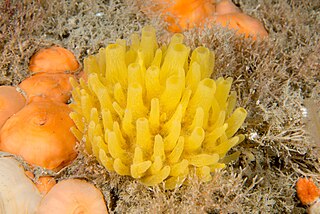
The Clathrinida are an order of calcareous sponges found in marine environments. These sponges have an asconoid structure and lack a true dermal membrane or cortex. The spongocoel is lined with choanocytes.

Polymastia is a genus of sea sponges containing about 30 species. These are small to large encrusting or dome-shaped sponges with a smooth surface having many teat-shaped projections (papillae). In areas of strong wave action, this genus does not grow the teat structures, but instead grows in a corrugated form.

Chondrocladia is a genus of carnivorous demosponges of the family Cladorhizidae. Neocladia was long considered a junior synonym, but has recently become accepted as a distinct genus.

Homosclerophorida is an order of marine sponges. It is the only order in the monotypic class Homoscleromorpha. The order is composed of two families: Plakinidae and Oscarellidae.

Plakinidae is a family of marine sponges. It is composed of seven genera:
Ascandra izuensis is a species of sea sponge in the family Clathrinidae. The species is named after the Izu peninsula where the holotype was collected.
Clathrina multiformis is a species of calcareous sponge from Russia.
Racekiela ryderi is a species of freshwater sponge in the family Spongillidae. It was first described by Edward Potts in 1882. It was collected on Sable Island in 1899 by John Macoun, a biologist with the Geological Survey of Canada, and given the name Heteromeyenia macouni by A.H. Mackay in 1900. It was originally assumed to be endemic to Sable Island but is now considered to be the same species as Racekiela ryderi, which is more broadly distributed.

Ancorinidae is a family of marine sponges belonging to the order of Tetractinellida.

Pachymatisma is a genus of sponges belonging to the family Geodiidae.
Guancha apicalis was thought to be a species of calcareous sponge in the genus Guancha from Antarctica. It actually never existed.

Oscarellidae is a family of marine sponges.

Bubarida is an order of demosponges in the subclass Heteroscleromorpha.
Tethyida is an order of sea sponges in the subclass Heteroscleromorpha.

Agelasida is an order of sea sponges in the class Demospongiae.

Spongillida is an order of freshwater sponges in the subclass Heteroscleromorpha.
Baeriidae is a family of calcareous sponges in the class Calcarea. It was named by Borojevic, Boury-Esnault, and Vacelet in 2000. The type genus is BaeriaMiklucho-Maclay, 1870, by original designation, though Baeria is now considered a junior synonym of LeuconiaGrant, 1833.
Nicole Boury-Esnault is a retired French researcher of sponges, formerly at Centre d'Océanologie de Marseille, Aix-Marseille University.
Jean Vacelet is a French marine biologist who specialises in the underwater fauna of the Mediterranean. After earning his licence at the Faculté des Sciences de Marseille and learning to dive in 1954, he specialised in the study of sponges at the Marine station of Endoume, and there he has stayed faithful to both sponges and place for more than half a century. His research has included all aspects of sponges: taxonomy, habitat, biology, anatomy, their bacterial associations, and their place in the evolution of multi-celled animals. He has studied them not only in the Mediterranean but in the Indian Ocean and the Pacific. Exploration of underwater grottoes, together with Jacques Laborel and Jo Hamelin, revealed the existence of sponges dating from very ancient geological periods and the unexpected existence of carnivorous sponges, and surprisingly, the grottoes in some ways mimicked life at much greater depths.









